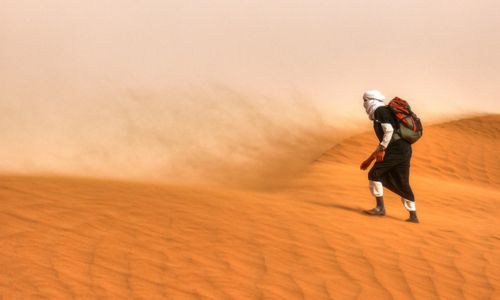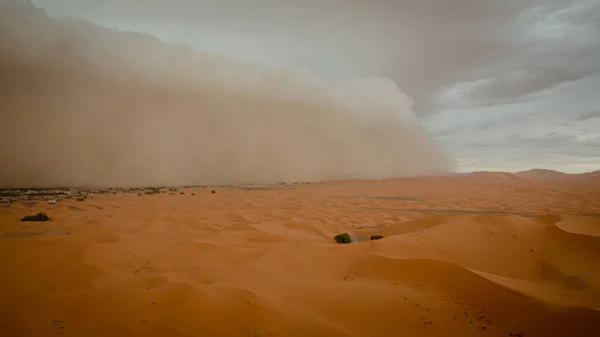Sahara Sand Storm
A sandstorm is a meteorological phenomenon that manifests itself by strong winds causing the deflation and transport of sand particles in the atmosphere, by the process of saltation, or even by suspension for fine sands. Dust storms are similar but the substrate raised is the dried out soil. They leave sand mists in their wake or afterwards which contribute to air pollution by particles.
Sahara sand storms are common so if you are planing a trip to Sahara desert this information may interest you, specially what to do if you find yourself in a Sahara sand storm.

Summary:
1 Meteorological causes
2 Action of the wind
3 Consequences, sometimes amplified by humans
4 Sahara sand storms
5 What to do in a Sahara sand storm
Meteorological causes of sand storms
There are several phenomena that can raise sand or dust to give such storms. They can be classified into two categories:
Intense weather lows and fronts that generate strong to violent winds over a diameter of several hundred kilometers ; mesoscale effects, such as thunderstorm lines, where winds from the middle levels of the atmosphere are driven down to the ground forming a more limited gust front that can sweep over a region.
Synoptic storms
In the first case, the wind action covers large areas and lasts up to a few days. They will lift the thin surface layer in a desert region and give reduced to zero visibility depending on their speed variations. This is an effect similar to blowing snow, or high snowfall, in a snowstorm.
It is often a strong area of winds approaching a cold or quasi-stationary front in the summer period in the inter-tropical convergence zone. There is usually a strong wind parallel to the front in this situation which lifts the sand or dust. However, in winter, it is usually the winds behind and perpendicular to the front that are very strong because of the intrusion of cold air from the front that makes the air unstable.
One of the synoptic-scale sandstorms occurs when a northerly wind, called “Shamal” or “Chammal”, blows over the Arabian Peninsula. This occurs in the summer behind a cold front; and in the winter when there is a strong circulation between a high over the peninsula and a low east of the Persian Gulf. Other winds known from desert areas give sandstorms on the same scale as the Harmattan, the Simoun, the Sirocco, etc.
Mesoscale storms
In the second case, the area of strong winds is limited but intense. The most spectacular of these phenomena is the “haboob”, according to the Arabic name given to this phenomenon that can be found almost everywhere in desert areas3. It consists of downbursts generated by a thunderstorm or a line of thunderstorms. In a dry environment, the rain often evaporates before the ground and the air coming down from the storm spreads out in a gust front raising a wall of sand or dust that can be up to a hundred kilometers long but much less wide3. This limits the duration of poor visibility at a given point to three hours or less, but the wall can travel very long distances before friction causes the winds to subside.
An even more limited phenomenon occurs on sloping sandy coastal plains during sea breeze situations but stable air aloft. In this situation, the breeze is from the sea to the land, while aloft there may be a low-level jet stream of opposite direction. The air coming from the sea is lifted by the slope which locally breaks the temperature inversion and allows the colder upper wind to descend towards the ground because it is undergoing a negative buoyancy. This sudden strong wind can then cause a very localized sandstorm but also has the effect of cutting off the breeze which limits its life.
Finally, there are places where the wind is forced through openings in the terrain that accelerate the wind by the Venturi effect (corridor wind). If these strong winds blow in a desert area, they will create a localized sand or dust storm.
WIND ACTION
Sand or dust moves in three ways :
Reptation, the wind moves the larger grains in a gradual movement without loss of contact with the underlying mass;
Saltation, the lighter particles are lifted by the wind to a certain height and fall back under their own weight, bouncing and ejecting other particles by impact. This lifting is of the order of a few centimeters to a few tens of centimeters;
Turbulent diffusion/suspension, the very light grains can be caught in a mechano-thermal turbulence by the winds which transport them at a great distance by lifting them up to several tens or hundreds of meters in height.
When the wind speed is below a certain threshold, which depends on the density and cohesion of the soil, there is generally no particle transport. It is mainly the suspension of very fine particles that causes storms, but the saltation of slightly coarser particles contributes at low levels to poor visibility.
Consequences, sometimes amplified by humans
Sandstorms can have important consequences, direct and indirect, and sometimes remote for the environment (oceanic in particular) or for public health (Thus the Saharan dust flies cause sand mists in the West Indies, which have recently (2018) been shown to contribute to particulate air pollution and are then notably a cause of premature births).
Some of these storms had consequences aggravated by human actions that had already degraded the landscape and made soils more vulnerable (deforestation, agriculture, plowing…).
The “Sea of Sand” (Zandverstuiving) in the Dutch Hoge Veluwe Park is the result of the effects of a storm that washed away degraded agricultural soil over hundreds of hectares (central Netherlands).
Some of the effects of the dust storms that affected North America in the nineteenth and early twentieth centuries have a human cause. European settlers had cut down vast forests and cultivated hundreds of thousands of hectares of former natural grasslands that had previously protected fragile soils (loess). These bare soils, degraded by ploughing and dehydrated by the sun, took on a powdery consistency, and were swept away by storms until the bedrock was exposed and caused the bankruptcy of thousands of farmers, contributing to the economic crisis of 1929. This is why it was in Canada and the United States that more extensive and/or no-till farming techniques were first developed, which effectively protected the soil.
Similarly, overgrazing and the proliferation of voles following the decline of their predators have degraded and weakened the soils of Mongolia, leading to desertification phenomena, with sand and dust flying around and clouding the atmosphere as far as eastern China. These clouds can modify the climate and rainfall, and by transporting bacteria, viruses and other pathogens, while decreasing the disinfectant activity of solar ultraviolet, they could have health impacts.
Such phenomena have become rarer in North America, but more frequent in Asia (in addition to the impacts of forest fires), and if they are rare in the European temperate zone, they are nevertheless not excluded. For example, the “sea of sand” in the Hoge Veluwe Park in the center of the Netherlands is a former cultivated sandy agricultural area, whose fertile soil, dehydrated by a period of drought, was literally washed away by a violent storm in the early 20th century, before being purchased by a wealthy industrialist for pine planting and hunting, after which the area reverted to nature. The sea of sand is now maintained by an adapted management, for landscape and heritage reasons.
Saharan dust storms
In the Sahara, the sandstorm is a frequent phenomenon. It can last two or three days. The very fine sand can be transported hundreds of kilometers outside the desert: in southern Tunisia, after each sandstorm, the slopes opposite the direction of the wind are sprinkled with sand brought from the Great Erg.
WHAT TO DO IF YOU FIND YOURSELF IN A SAND STORM. HOW TO SURVIVE TO A SAHARA SAND STORM
Reflexes to adopt if you are on foot
Cover your mouth and nose. If you have a respirator or mask designed to filter out small particles, put it on right away. If you don’t have one, wrap a bandana or other cloth around your nose and mouth. Moisten it slightly if you have enough water. Apply a small amount of petroleum jelly to your nostrils to prevent your mucous membrane from drying out.

Protect your eyes. Conventional goggles do not offer enough protection from dust or sand, but waterproof goggles do. If you don’t have one with you, protect your face with your arm and then wrap a piece of cloth around your head to protect your eyes and ears.
Seek shelter. Even a parked car will do as long as it is not in the road and not in danger of being hit by another vehicle. Anything “downwind” (that protects you from the wind) of the storm will be better than nothing, however. Sand will bounce off objects and you should cover your skin and face as much as possible. If you can’t find shelter, stay crouched down so you don’t get hit by a windblown object.
Go to an elevated location. The greatest concentration of sand or dust is near the ground, which means that the storm will be less severe on top of a hill. So go to an elevated location if you can find a safe, solid, high place, but only if the storm is not accompanied by lightning, and if there is no risk of getting blown over by objects.
Do not lie in a ditch, as flooding may occur even if it is not raining where you are. In the dust cloud, rain evaporates before it reaches the ground, but it may rain nearby, and ditches, arroyos, and other sunken areas may quickly fill with water.
If you have a camel, sit it down and lean against its side on the leeward side. Camels are naturally adapted to survive dust storms.
If you are in the desert, do not take shelter on the leeward side of the dunes. The strong winds can kick up huge amounts of sand in a short period of time and you could be buried.
Protect yourself from windblown objects. Look for a large rock or object that will at least partially protect you. Cover up as much as possible to protect yourself. Windblown sand can hurt, but it can also be accompanied by heavier (and more dangerous) objects. If you are out in the open, stay low to the ground and protect your head with your arms, a backpack or a pillow.
Wait for the storm to subside. Do not try to move through the storm as it is too dangerous. Stay where you are and wait for the wind to stop before moving on.
If you can get to a shelter before the storm arrives, do so as quickly as possible and stay inside. Close all doors and windows and wait for the wind to die down. If you are with others, stick together so no one gets lost.
What to do if you are in a car?
Drive to a shelter or stop the car.
Do not drive in the direction of the storm.
Warn other passing passing cars.
Turn on your headlights.
First close the windows of your car and close all the
and turn off the air conditioning.
How to anticipate the risk of a sandstorm?
Find out about about the areas risk areas. Listen to the radio for information. Prepare a protection kit in case of in case of a sandstorm and
bring it in your car
DISCOVER OUR TOURS TO SAHARA DESERT IN MOROCCO

FROM MARRAKECH
Our most popular Morocco Sahara Tours . The trip from Marrakech is rich in scenery and includes an unforgettable stay in a Desert Camp.

FROM FES
A great experience starting from Fes including camel trekking and at least one night in a tented desert camp in the Merzouga Desert.

CUSTOM TOURS
Our experts can create exceptional tailor-made experiences for our clients. Contact us and we´ll plan your perfect trip in Morocco.

